#solidago sp.
Explore tagged Tumblr posts
Text







Really great plants at the park today
#differential grasshopper#orange jewelweed#american senna#hairy white oldfield aster#new england aster#tall boneset#goldenrod#illinois native plant#river park#Impatiens Capensis#symphyotrichum pilosum#senna hebacarpa#symphyotrichum novae-angliae#solidago sp.#eupatorium altissimum#chicago
8 notes
·
View notes
Text
Wildflower Walk ?
Hello everyone! I hope this post finds you all well. I apologize for not posting for a while. It has been a weird summer for sure with the heat and drought. I was busy with the garden picking sweet corn and green beans right up until August 17. Somehow I managed to get 455 ears of sweet corn in the freezer, and thanks to the ‘Provider’ green beans, 34 quarts of green beans. Of course, not all the…
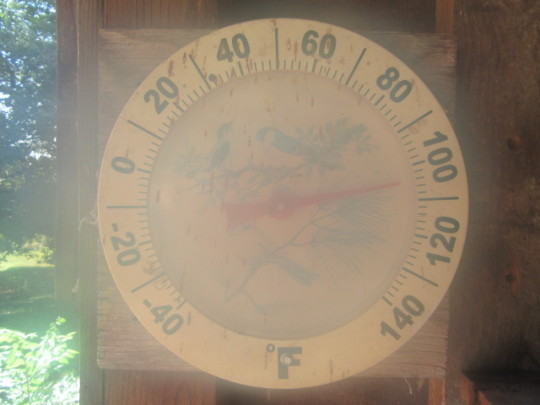
View On WordPress
#Ambrosia bidentata (Lanceleaf Ragweed)#Asclepias hirtella (Prairie/Tall Green Milkweed)#Asclepias syriaca (Common Milkweed)#Bidens aristosa (Tickseed Sunflower or Bearded Beggarticks)#Datura stramonium (Jimson Weed)#Elephantopus carolinianus (Leafy Elephant&039;s Foot)#Erechtites hieraciifolius (Fireweed/Pilewort)#Erigeron annuus (Annual or Daisy Fleabane)#Etc.)#Eupatorium serotinum (Late Boneset)#Impatiens capensis (Jewelweed)#Lespedeza cuneata (Chinese Bushclover)#Persicaria hydropiper (Water Pepper)#Persicaria pensylvanica (Pinkweed)#Phytolacca americana (American Pokeweed)#roton capitatus (Hogwort/Woolly Croton/Goatweed)#Rudbeckia hirta (Black-Eyed Susan)#Sida spinosa (Prickly Fanpetals)#Solanum sarrachoides (Hairy Nightshade)#Solidago sp. (Goldenrod)#Symphyotrichum lateriflorum (Calico Aster)#Tridens flavus (Purpletop#Tripsacum dactyloides (Eastern Gamagrass)#Verbesina virginica (White Crownbeard/Frostweed)#Vernonia missurica (Missouri Ironweed)
0 notes
Text




Throwback to last October's visit to Konza Prairie near Manhattan, KS. These plants are likely buried under snow and ice now, but their seeds wait patiently for spring's warmth to call them up out of the soil.
[Clockwise from top left: Milkweed (Asclepias sp.), goldenrod (Solidago sp.), Canada wild rye (Elymus canadensis), little bluestem (Schizachyrium scoparium)]
#grass#prairie#Konza#Konza Prairie#Kansas#tallgrass prairie#old growth#nature#ecology#plants#native plants#wildflowers#plantblr#naturecore#habitat restoration#hiking#outdoors#TBT
47 notes
·
View notes
Text
Saw a Solidago today that was crawling with yellow and black insects.

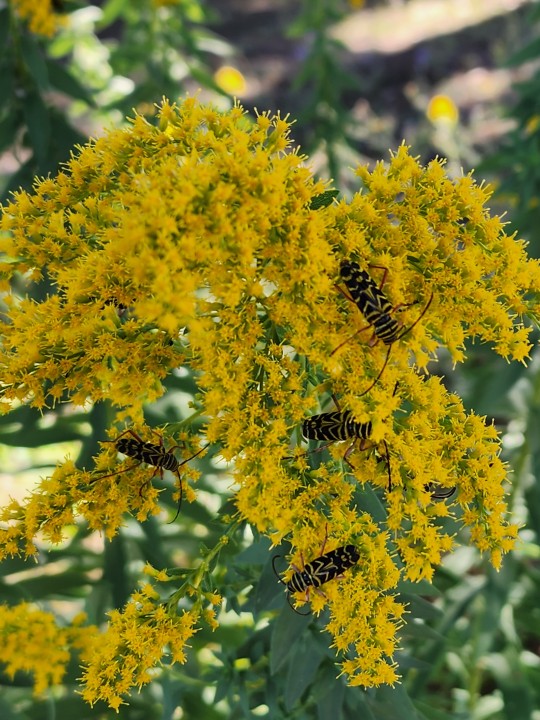
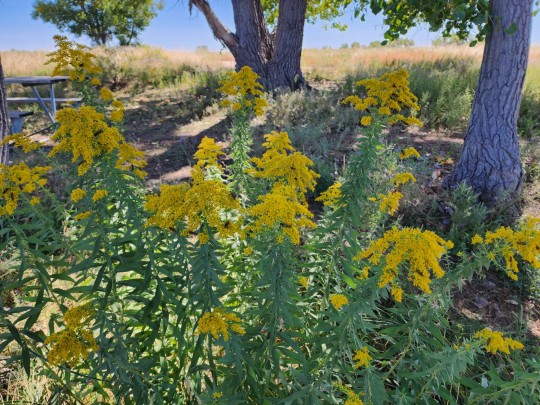
Image ID. Some yellow goldenrod flowers with a bunch of bugs on it. End ID.
At first I thought it was just the beetles (locust borers, Megacyllene robiniae), but there were also a couple wasps (Polistes sp. and somebody from Halictidae) and wasp mimic hover flies (probably Spilomyia).

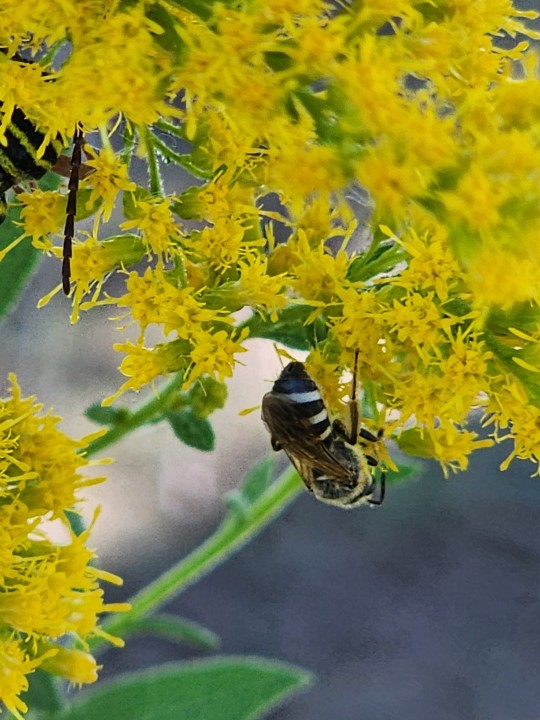

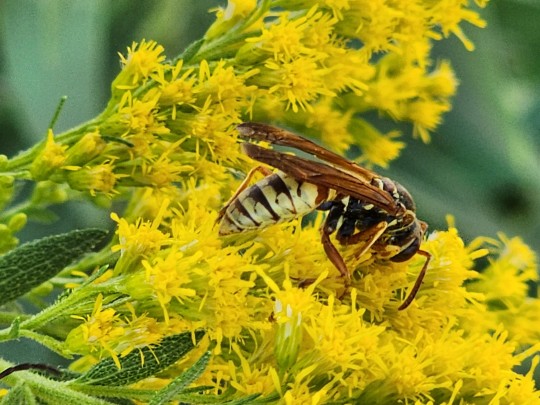
Image ID. Closer shots of the bugs in question. All are striped in bright yellow and black, but they are a beetle, a bee, a fly, and a wasp. End ID.
#insects#harper talks#solidago#wasps#hymenoptera#coleoptera#beetle#mimicry#biology#diptera#flies#goldenrod
8 notes
·
View notes
Text
Fun Fact: Goldenrod does NOT cause seasonal allergies!
At this time of year, I am suffering from seasonal allergies (ಥ_ಥ). And in honor of these seasonal allergies, I’d like to clear the good name of an innocent plant which has long been blamed for seasonal allergies.
Ahem:
Goldenrod is INNOCENT!!!!!

(I love goldenrod (Solidago spp.) and WILL NOT STAND FOR THIS SLANDER)
Now, that isn’t to say that no one is allergic to goldenrod, at all. Some people are, indeed, allergic to this plant, but it is relatively rare and only cause reactions when direct physical contact takes place. These goldenrod allergies do NOT cause the stuffy noses and watery eyes that seasonal allergy sufferers are familiar with (and which I am currently suffering from 😭😭😭😭).
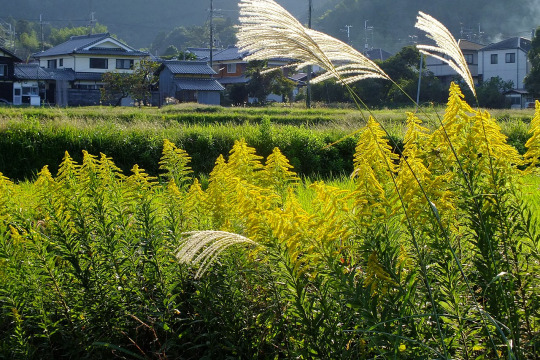
(an innocent bystander 😔)
“But wait!”, you may say, “Every year, without fail, seasonal allergies attack just as the goldenrod begins to bloom!” And this is a fair assumption! There are many times in life where the things we see are causing the things we experience. However, in this case, seasonal allergies and goldenrod flowers are connected by correlation, not causation.
How can I be so sure? Well, because goldenrod pollen is not airborne!
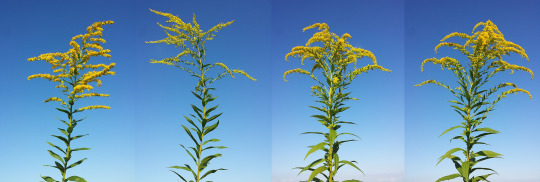
(they’re so good, so pure, so not-currently-attacking-my-airways)
Goldenrod is a plant which is pollinated by animals, primarily insects. Because of this, its pollen is big, heavy, delicious and can’t make it too far from the plant, even with a BIG gust of wind. Instead, an insect covered in goldenrod pollen will fly to a different goldenrod plant, transporting and delivering the pollen in a highly efficient manner, because that is where the plant intends for the pollen to go! Really, goldenrod pollen is unlikely to ever get into your nose (unless you sprinkle it in directly).
Instead, the culprit for your seasonal allergies is MUCH more likely to be an enemy you may have heard of: ragweed.

(*holds up sign that says “Audience Boos”*)
It just so happens that ragweed (Ambrosia spp.) and goldenrod (Solidago spp.) both bloom around the same time, and in the same sorts of environments.
Goldenrod is bright yellow and extremely conspicuous, while ragweed.... well, it doesn’t exactly jump out, visually:
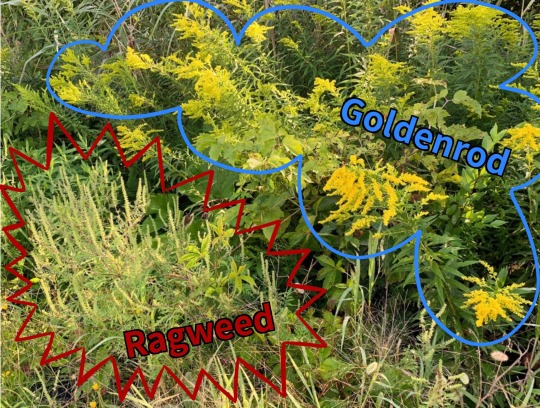
(I circled and labelled them because the ragweed doesn’t exactly… pop out of the picture. ©Janet Allen)
People notice their allergies and then notice the highly conspicuous goldenrod, and they consider the mystery solved. Meanwhile the ragweed remains, hidden in plain sight and the TRUE guilty party.
Ragweed is my eternal enemy the most common cause of seasonal allergies in North America. One reason for that is because ragweed, rather than being pollinated by insects, is instead pollinated via wind, which basically means the plants produce a LOT of very tiny, airborne pollen (about a billion particles per plant), and just hopes that one lands on a different ragweed plant eventually, travelling up to 600 km away. Unfortunately for allergy sufferers, the vast majority of the pollen does not make it to another plant and apparently ends up in my nose instead.
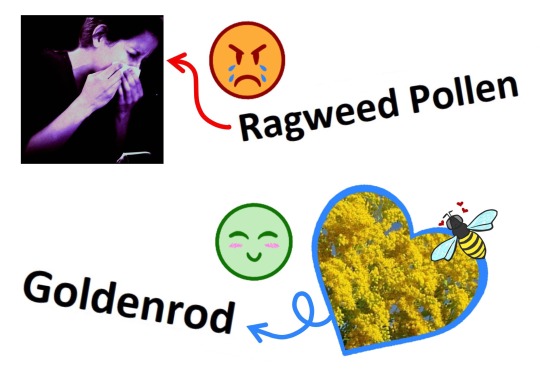
(things that do cause my allergies: ragweed, horses, and mold spores. Things that do NOT cause my allergies: goldenrod.)
Now, I am being a little bit mean to ragweed here, but in my defence, I cannot currently breathe through my nose as a direct result of ragweed, and it has put me in a mean sort of mood (ಠ╭╮ಠ). this is my villain origin story.
That said, I would be remiss not to mention that ragweed is native to North America (although they are VERY invasive in many other places in the world), and so it... I’m sure... that ragweed... it contributes... to the ecosystem... somehow... and we should respect it... instead of assigning... subjective value judgements... to nature (I say, shaking, crying, visibly pained).
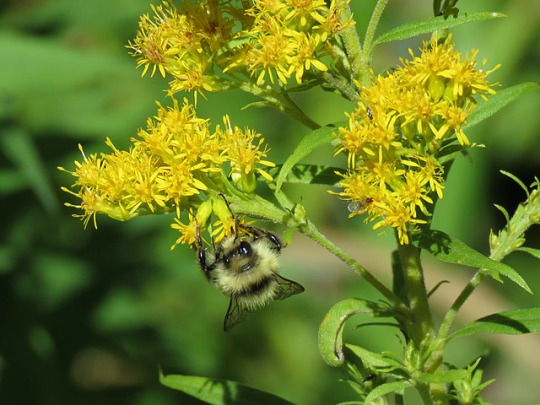
(a bumblebee (Bombus sp.) enjoying some goldenrod 🥰)
Goldenrod, on the other hand, is native to North America and is ONE OF MY FAVOURITE THINGS, simply because pollinators LOVE these flowers! I can sit for literal HOURS at a single plant, watching the dozens of different pollinators coming and going. It is also invasive in many other places in the world but THIS ISN’T ABOUT THAT 😭😉😉😉
This has been Fun Fact Friday, where I will defend the honour of goldenrod with my life!
(also: guys there are SO MANY pictures of goldenrod on the internet mislabeled as ragweed, it’s actually blowing my mind. Stock image sites are particularly terrible about this. THE WORLD NEEDS TO KNOW THE TRUTH.)
#biology#plants#allergies#science#ecology#science side of tumblr#sciblr#STEM#fun facts#fun fact friday#adhd in STEM#ragweed#goldenrod
175 notes
·
View notes
Photo

Goldrute, Solidago | Aaron’s rod, goldenrod
Solidago sp.
47 notes
·
View notes
Photo



Common Eastern Bumble Bee Bombus impatiens Apidae Family
... on goldenrod (Solidago sp.).
Photographs taken on September 20, 2020, at Marmora and Lake, Ontario, Canada.
#wildflowers of southern ontario#Common Eastern Bumble Bee#Eastern Bumble Bee#bumble bee#bee#Bombus impatiens#bombus#Apidae#bees#goldenrod#solidago#marmora and lake#insect#ontario#canada
9 notes
·
View notes
Photo










Went to Alberta saw some plants and my family. Anticlea eleagans, two Symphyotricum sp.’s, A. eleagans and Hedyasarum sp. (maybe boreale), Chamaenerion angustifolium and Populus tremuloides, Calendula rows, summit of Prairie Mountain, the meadow there with more A. eleagans, cows in the shade, more C. angustifolium and Solidago sp.
1 note
·
View note
Text

Some kinda goldenrod - Solidago sp.
10 notes
·
View notes
Photo




Ohio River Valley was known for extreme diversity in it’s early years before honeysuckle, winter creeper, winged burning bush, and kudzu were promoted by the early horticultural horrors of the European settlers. Widening of the river and promotion of power plants, mills, and locks meant many of the natural features would be gone forever. Limestone Glades/ barrens of the Ohio River Valley on the Indiana and Kentucky side, found as vestigial remnants housed in state parks are the last refugial locations for native populations of this species of Goldenrod.
Short’s Goldenrod,
Solidago shortii,
many of you are familiar with long seasonal much larger CV. called ‘Golden Cascade’ that is still around today from the early “poach that sport ol’ chap” era of the early 1900′s where many species were locally extirpated from counties.
Because of it’s past history, it’s lack of habitat, the distance between populations, the lack of genetic vigor, and the population sizes them selves. It has been put on the Federally Threatened species list along with a few other Solidago sp. that you may have seen on this blog( White haired GR, Blue Ridge GR).
It is named after Dr. Charles Wilkins Short whom’st’ve first discovered this plant in 1840 growing on a limestone outcrop called Rock Island within the Falls of the Ohio River(RIP) near Louisville, Kentucky. Plants at this original site disappeared in the early 1900s, at least in part because dam construction on the Ohio River destroyed the habitat. The only know populations of this goldenrod today are the Blue Lick Springs area of northeastern Kentucky (14 populations in Fleming, Nicholas and Robertson Counties) and along the Blue River in Harrison-Crawford State Forest in southern Indiana (1 population) and a population near Clifty Falls State Park( 1 Population aka this one).
#solidago shortii#solidago#asteraceae#botany#plantblr#plants#plantblog#plant blog#nature#ecology#wildflowers#indiana#cottagecore
27 notes
·
View notes
Text
Mary Garden from FishEater.com
Mary Gardens: Flowers for Our Lady
Common Name
Scientific Name
Medieval Name and/or Religious Meaning
Amaryllis Amaryllis belladonna Beautiful LadyAmaryllis Hippeastrum hybr. St. Joseph's LilyAnemone, double-flowered Anemone coronaria St. BrigidAster Aster nova-belgii Michaelmas Daisy
(September)
Baby's Breath Gypsophila panicul. Lady's VeilBachelor's ButtonsCentauria cyannisMary's CrownBean caper plant Zygophyllum dumosum ? Found on Shroud of Turin. See footnote for more information on the flowers of the Holy Shroud. Begonia Begonia fuchsioides Heart of Jesus Begonia Begonia fuch. rosea Heart of Mary BellflowerAdenophera Lady BellBird of ParadiseStreliztia reginae Bird of ParadiseBlack-Eyed Susan Rudbeckia hirta Golden JerusalemBleeding Heart Dicentra spectabilis Mary's HeartBlue Phlox Phlox divaricata Lady's WeddingBluets Houstonia caerul. Madonna's Eyes Bougainvillea Bougainvillea gen. TrinitariaButtercup Ranunculus acris Lady's Locks Buttercup Ranunculus sp. Our Lady's Bowl CameliaCamellia (japonica)(Purity)Calla LilyZantedeshia aethiop.St. Joseph's StaffCanna Canna generalis Rosary BeadsCanterbury Bells Campanula medium Our Lady's Nightcap, Mary Bells, Our Lady's SmockCaper, Caper bushesCapparis spinosa (var. aegyptia) ? Found on Shroud of Turin. See footnote for more information on the flowers of the Holy Shroud. Carnation Dianthus caryophyllus Mary's Love of God. These flowers are said to have bloomed at Christ's Nativity, according to a German legend.
(January)
Castilian roses (Damascus Roses or Damask Rose)Rosa damascenaI am not sure of the medieval name for these native-to-Spain flowers, but these are the variety that St. Juan Diego found after the vision of Our Lady at Guadalupe.Chrysanthemum (mum) Chrysanthemum All Saints' Flower. Chrysanthemums in general are associated with death and are used and funerals and to adorn graves (Chrysanthemum coronarium is believed by scientists to have been present when Christ was laid in the tomb. See footnotes).
(November)
ClematisClematis virginiana Virgin's BowerClematisClematis (flammula) CrossColumbine Aquilegua vulgaris Our Lady's Shoes, Lady's Slipper. Said to have sprung up under Our Lady's feet as she went to visit Elizabeth. The dove-shaped petals of this flower invited -- and invites -- its use for decoration on the Feast of the Pentecost.Corn MarigoldChrysanthemum segetum Mary's Gold
(November)
CosmosCosmos sp. St. Michael's Flower
(September)
CostmaryChrysanthemum bals. Mary's LeafCowslipPrimula verisLady's KeysCrocus Crocus vernus Penitent's RoseCross VineBignonia capreolata Cross VineCrown DaisyChrysanthemum coronarium ? I don't know the medieval name for this flower, but "Crown Daisy" is appropriate: this flower shows up on the Shroud of Turin. See footnote for more information on the flowers of the Holy Shroud. Daffodil Narcissus pseudo-narc. Mary's StarDahlia Dahlia (hybrids) Churchyard FlowerDay Lily Hemerocallis flava St. Joseph's LilyDieffenbachia Dieffenbachia sao ant. St. Anthony DieffenbachiaDog RoseRosa canina Mary's ThornDutchman's BreechesDicentra cucullariaI don't know the medieval name for this interesting flower, but it has sentimental interest for me so I would love to discover it if anyone happens to know and cares to write.Edelweiss Leontopodium alp. PurityEaster Lily Lilium longiflorum Easter LilyEnglish Daisy Bellis perennis Mary-Love English Holly Ilex aquifolium Burning BushEvening Primose Oenothera biennia Easter CandleFern Asplenium ruta-mur. Lady's HairField BindweedConvolvulus arvensisThis lovely flowering plant -- closely related to, resembling, and sometimes called the same name as the Morning Glory -- is pervasive once planted and, so, is generally considered a weed. Its old common name according to the Grimm's short tale of the same name is "Our Lady's Little Glass." The story in its entirety: "Once upon a time a waggoner's cart which was heavily laden with wine had stuck so fast that in spite of all that he could do, he could not get it to move again. Then it chanced that Our Lady just happened to come by that way, and when she perceived the poor man's distress, she said to him, 'I am tired and thirsty, give me a glass of wine, and I will set thy cart free for thee.' 'Willingly,' answered the waggoner, 'but I have no glass in which I can give thee the wine.' Then Our Lady plucked a little white flower with red stripes, called field bindweed, which looks very like a glass, and gave it to the waggoner. He filled it with wine, and then Our Lady drank it, and in the self-same instant the cart was set free, and the waggoner could drive onwards. The little flower is still always called Our Lady's Little Glass."Forget-me-not Myostis scorpoides, Myostis sylvatica Eyes of MaryForsythia Forsythia suspensa Easter BushFoxglove Digitalis purpurea Our Lady's GlovesFuchsiaFuchsia speciosa Christ's Blood Drops or Our Lady's EardropsGeranium Pelargonium (dom) Lady BeautifulGeraniumPelargonium sp. Heart of Jesus, Gentle VirginGerman Iris lris germanica Mary's Sword of SorrowGladiolusGladiolus sp. Twelve Apostles, Ladder to HeavenGolden Rod Solidago canad. Lady's Plant Grape HyacinthMuscari (gen) St. Joseph's BellsGrape Hyacinth Muscari botryoides Church SteeplesGround Ivy Nepeta hederacea Madonna's Herb Hawthorn
Crataegus monogynaMary's Mayflower
(May)
HawthornCrataegus oxyacanaMary's Berry
(May).
The Crataegus Oxyacantha praecox variety is the plant of England's "Glastonbury Thorn" -- a plant of Mediterranean origin but which, in Somerset, blooms twice: at Easter and at Christmas. It, therefore, has become a symbol of Christmas. The Glastonbury Thorn is said to have arisen when St. Joseph of Arimathea thrust his hawthorn staff into the ground in Somersetshire. The original plant was destroyed by Puritans (the soldier who did the chopping is said to have been struck in the eye by a large splinter from the tree), but shoots from it were taken, and England's Glastonbury Thorn lives. Since 1929, blossoms from the Glastonbury Thorn are sent to England's Monarchs for their table on Christmas Day.Heather Calluna vulgaris Lady's Adversary Holly (Christmas Holly)Ilex opaca. var. Christmas Holly
(December)
Holly (English Holly) Ilex aquifolium Burning BushHollyhock Althea rosea St. Joseph's StaffHoneysuckleLonicera caprifol., Lonicera (japonica) Lady's Fingers
(June)
HoneysuckleLonicera xylosteum Lady's Stick
(June)
Hosta (Plantain Lily)Hosta plantagineaAssumption LilyHyacinth Hyacinthus oriental. Lily-Among-Thorns, Lily-of-ValleyHydranga var. Hydranga macro. mar. Ave MariaImpatiensImpatiens Wallerana Our Lady's Earrings, or Mother LoveIvy Hedera helix Where God has WalkedJasmineJasminum officinale MaryJob's TearsCoix lachryma-jobiJob's Tears (Job 16:20). The seeds of this plant are often used for Rosary beads.Jonquil Narcissus jonquilla (December) St. Joseph's StaffJudas TreeCercis siliquastrumSaid to be the tree upon which Judas hanged himself after betraying Our Lord. It is a beautiful tree, with lovely pink flowers in the Spring.Larkspur
Delphinium ajacis, Delphinum (grandif.) Mary's Tears
(July)
Lavender Lavendula (offic.) Flight into EgyptLilac Syringa vulgaris Ascension FlowerLily-of-the-ValleyConvallaria majalis Our Lady's Tears. These flowers are said to have blossomed from Mary's tears for her Son as she stood at the foot of the Cross.
(May)
Lungwort Pulmonaria officinalisMary's Milkdrops, Our Lady's Milk Herb, The Virgin Mary's TearsMadonna Lily Lilium candidum Annunciation Lily, Virgin Lily or Mary's Lily
Note: The Venerable Bede (A.D. 672-735) described the white petals as symbols of Mary's body, and the golden anthers as symbols of the glory of her soul. Roses and lilies were said to have filled Mary's empty tomb when it was opened by the Apostles. While lilies' association with purity cause them to be depicted with many Saints, such as SS. Francis and Claire, they are most strongly associated with St. Joseph, whose rod is said, in the Gospel of the Nativity of Mary, to have blossomed to prove he was worthy to guard Mary and become her spouse; with St. Anthony of Padua, because lilies left in chuches on his Feast Day miraculously remained fresh during the French Revolution; and with the archangel Gabriel, who is depicted as presenting Mary with the lily at the Annunciation (hence the name "Annunciation Lily"). Lilies are also associated with Solomon's Temple (III Kings 7:19-22), and their beauty is commented on by Christ Himself (Luke 12:27).Maltese CrossLychnis chalcedonica "Maltese Cross" (or "Jerusalem Cross"). The shape of these flowers' petals strongly evokes the Maltese Cross, and they are said to have been introduced into Europe, from Russia and Siberia, by the crusading Knights of Malta.MarigoldCalendula officin. Mary's Gold
(October)
MeadowsweetFilipendula ulmar.Our Lady's BeltMillfoilAchillea millefoliaChrist's Back, Our Lord's BackMistletoe Viscum album CrossMoonflowerCalonyction acul.Lady-of-NightMorning GloryIpomoea purpurea Our Lady's Mantle
(September)
Nasturtium Tropaeolum majus St. Joseph's FlowerOrchid Orchis purpurea Lady Orchis Orchid Brassavola nodosa Lady-of-Night Orchid Orchis maculata Gethsemani Oriental PoppyPapaver orientale Christ's Blood, Crucifixion Blood-Drops
(August)
Ox-Eye DaisyChrysanthemum leucanthemum Mary's Star. The legend told is that the Magi followed the star to Bethlehem but weren't sure where to go once there. King Melchior then saw the ox-eye daisy growing, which looked very much like the star they'd followed. He picked it, and the door to the stable opened revealing the Holy Family.Pansy Viola tricolor Trinity Flower, Our Lady's DelightPassion FlowerPassifloraPassion Flower, whose 5 stamens symbolize the Five Wounds of Christ; the outer fringe, the crown of thorns; and stigmas, the nails. See more
here
. PeriwinkleVinca rosea Virgin FlowerPetunia Petunia hybr. Lady's PraisePeony Paeonia officinalis Pentecost Rose (does anyone know of any name or meaning associated with Paeonia lactiflora?)PinkDianthus (gen)Mary's PinkPoet's Narcissus Narcissus poeticus Lady's RosePoinsettia Euphorbia pulcherima Nativity Flower, Christmas StarPot Marigold Calendula officinalis Mary's GoldPrimrose Primula elatior Mary's Candlestick
(February)
Primrose Primula vulgarisLady's Frills
(February)
Quaking GrassBrizaLady's Tresses, Our Lady's BraidsRanunculus, double-flowered Ranunculus I don't know the medieval name for this flower, but it's a gorgeous blossom.RoseRosa White: Mary's Purity
Red: Mary's Sorrow and the Blood of Christ. Also martyrdom.
Gold: Mary's Glory
Red and White: Visitation
Note: The Rose symbolizes Mary herself (she is known as "The Mystical Rose," see
Litany of Loreto
) and is described in Dante's Paradiso when the guide asks him to contemplate Mary, "Why are you so enamored of my face that you do not turn your gaze to the beautiful garden which blossoms under the radiance of Christ? There is the Rose in which the Divine word became flesh: here are the lilies whose perfume guides you in the right ways."
Roses and lilies were said to have filled Mary's empty tomb when it was opened by the Apostles.
Roses are also associated with SS. Dorothy and Thérèse of Lisieux (who both send roses from Heaven), Elizabeth of Hungary, and Rose of Lima. St. Francis once threw himself on the thorns of a rosebush as penance. Since then, the rosebushes in that garden (near the cloister of Santa Maria degli Angeli in Assisi) have no thorns. See also the entry for Castilian Roses.
(June)
Rock RoseCistus (landanif.) Rose of SharonRock RoseCistus creticus? Shows up on Shroud of Turin. See footnote for more information on the flowers of the Holy Shroud. Rose of JerichoSelaginella lepidophylla
and
Anastatica hierochunticaThis desert plant survives in a curled up, dormant, brown, dessicated state for years, and then opens up and turns green with a bit of water. After returning to a lovely green, it goes dormant again when its water source is removed. Because of this fascinating property, it is often kept dormant in the home and brought out at Christmas time to blossom and then close in order to symbolize the opening and closing of Mary's womb. The plant is also known as the Resurrection Plant, Siempre Viva ("Everlasting"), and Dinosaur Plant. Read more about this plant on the
Rose of Jericho
page off the
Chrismastide Overview
page.Rose of Sharon Hibiscus syriacus Rose of Sharon Scabiosa Scabiosa columbariaMary's PincushionScotch ThistleOnopardon acanthium Judas' CloakSea PinkArmeria maritimaOur Lady's Cushion. These flowers are said to have made a place for Mary to sit during the Flight into Egypt.Shamrock Trifolium dubiuma symbol of St. Patrick and his evangelization of Ireland, and of Ireland itself -- but St. Patrick used it as a symbol of the Trinity, with each leaf representing a Divine Person while the plant remains one plant. Snapdragon Antirrhinum majus Infant Jesus' ShoesSnowdropGalanthus nivalus "Candlemas Bells" or "Purification Flowers." These flowers are said to have bloomed on Candlemas, when Mary took Jesus to the Temple for His "redemption."
(January)
Spanish Moss Mentha requienii Mother-of-ThousandsSpiderwortTradescantia zebrina (Zebrina pendula)Wandering Jew. The name for this plant -- often used as a houseplant -- derives from an old legend about a Jew who mocked and hit Christ during His Passion and so was condemned by Him to wander the earth until the Last Judgment. Two other species of this plant are also known by this name: Tradescantia fluminensis and Tradescantia pallida (Setcreasea purpurea, Purple Heart). Star-of-Bethlehem Ornithogalum umbellatum symbol of the star that led the Magi to ChristStockMathiola incana Our Lady's VioletStrawberry Frageria vesca Fruitful VirginSummor Phlox Phlox paniculata Christ's-Cross FlowerSunflower Helianthus annus Mary's GoldSweet AlyssumLobularia maritimaBlessed by Mary, Mary's Little CrossSweet Pea Lathyrus odoratus Our Lady's Flower
(April)
Sweet Pea Lathyrus pratensis Mary's Foot
(April)
Sweet William Dianthus barbatus Lady Tuft Tournefort's gundeliaGundelia tournefortii ? Found on Shroud of Turin. See footnote for more information on the flowers of the Holy Shroud. TuberosePolianthes tuberosaSt. Joseph's StaffTulip Tulipa gesneriana Mary's PrayerVioletViola odorata Our Lady's Modesty
(March)
Water LilyNymphaea alba Lady-of-the-Lake
(July)
Winter Rose (Snow Rose)Helleborus nigerChristmas Rose, or Lent Rose. A German Christmas symbol.Wisteria Wisteria frutescen Virgin's BowerWood Anemone Anemone nemorosa Candlemas Caps, Lady's NightcapYellow Flag IrisIris pseudocorusFleur-de-lis of French royalty, Mary as Queen, the Immaculate Conception YuccaYucca treculeana St. John's PalmZinnia Zinia elegans The Virgin, Church FlowerZinniaZinnia multiflora Little Mary, The Virgin
Herbs
Parsley Petrosolenium crisp. Our Lady's Little VineSage Salvia officinalis Mary's Shawl Rosemary Rosmarinus officin. Mary's Nosegay Thyme Thymus vulgaris The Virgin's Humility Chives Allium schoenopras. Our Lady's Garleek tarragon Artemisia dracunculusits botanical name means "Little Dragon" and evokes St. Martha's slaying of the dragon known as La TarasqueDill Anethium graveolens Devil-Away Coriander Coriandrum sativum St. John's Head Sweet Bay Laurus nobilis St. Bridget's Flower Basil Ocimum basilicum Holy Communion Plant. Pots of basil are used to decorate homes and to give away as gifts on St. Anthony of Padua's Day. Marjoram Origanum vulgare Mary's Bedstraw Cumin Cummin cyanum Cross-CumminFennel Foenlculum vulgare Our Lady's Fennel Anise Pimpinella anisum Our Lady's Sprig, Lady's Tobacco Spearmint Mentha spicata Mary's Mint Chicory Cichorlum intybus Heavenly Way Horehound Marrubium vulgare Mother-of-God's Tea, Mary's NettleSassafras Sassafras (albidum) Virgin's Tree Hyssop (Syrian Oregano)Origanum syriacumI am unable to find a medieval name for this plant, but include it because of its importance in the Passover, Psalms and Passion. The variety of hyssop properly called
Hyssopos officinal.
, and known as St. Joseph's Plant in the Middle Ages, is not the variety spoken of in the Bible and at the Mass. The Biblical plant is Origanum maru.Catnip Nepeta cataria Mary's Nettle Feverfew Chrysanthemum parth. Mary's FlowerFeverfew Parthenium hystero.Santa MariaChamomile Anthemus cotula Maiden Weed Chamomile Matricaria chamom. Lady's Flower St. John's Wort Hypericum perforatm St. John's Wort, Fuga Daemon ("Devil's Flight"), John's Blood, Jesus' Blood Drops, Christ's Sweat, Mary's Glory Spikenard (or "Nard")Nardostachys grandiflora (or Nardostachys jatamansi)The portion of the plant just above the roots has a patchouli-like scent which was used by Mary Magdalen in the ointment she used to annoint Christ.Dandelion Taraxicum officinMary's Bitter SorrowValerianValeriana officin. Lady's NeedleworkPennyroyal Mentha pulegium Lady's Flavoring
1 note
·
View note
Photo

Encontre a essência ideal para tratar o seu medo: 🎇Abundância (Plectranthus nummularius) - Fé e prosperidade. 🎇Abricó (Mimusops elengi) - Indicado aos desconectados, lentos no aprendizado ou no trabalho. 🎇Focum (Festuca elatior) - Remoção de traumas violentos desta ou de outras vidas. Indicado aos bebês que choram muito sem motivo aparente. Também para quem tem medo de dirigir. 🎇Jasmim Madagascar (Stephanotis floribunda) - Para quem tem dificuldade de se comunicar. 🎇Anis (Ocimum L.) - Aos que têm medo de viver, de se soltar na vida por imaturidade. 🎇Chapéu de Sol (Catappa L.) - Proteção contra a inveja. 🎇Goiaba (Psidium guayava) - Remove o medo. Traz coragem, segurança e tranquilidade nas situações de pressão. Para síndrome do pânico: Goiaba + Focum + Panicum. 🎇Incensum (Tetradenia riparia) - Limpeza tanto dos ambientes quanto dos corpos sutis. Usado nas meditações e orações. 🎇Carrapichão (Desmondium sp) - Combate o cansaço e a visão fraca. 🎇Arnica Silvestre (Solidago microglossa) - Trabalha auto cura. 🎇Cidreira (Cymbopogon citratus) - Indicado para quem possui preocupação excessiva e insônia. Cura o mental disparado que gera ansiedade. 🎇Allium (Allium L.) - Traz potente proteção. Trabalha a fé e a determinação. Traz tranqüilidade. 🎇Populus panicum (Coreopsis lanceolata) - Nas grandes catástrofes coletivas traz proteção contra o contágio do pânico coletivo. 🎇Panicum (Panicum maximum) - Indicado para a Síndrome do Pânico. 🎇Monterey (Cupressus monterey) - Trabalha a culpa, sentimento de inferioridade. Trabalha a criatividade. 🎇Mangífera (Mangifera indica) - Indicado aos que perderam a fé e a esperança. 🎇Pepo (Cucurbita pepo) -Trabalha a insegurança excessiva frente a sobrevivência do dia a dia. 🎇Myrtus (Myrtus communi) - Liberta do mental poderoso do outro, proteção. 🎇Lótus Magnolia (Nymphaea alba / Magnolia grandiflora) - Floral de proteção. 🎇Saint Germain (Merremia macrocalyx) - Indicado para depressão profunda. Traz a energia da luz, lucidez e da paz. 🎇Pinheiro Libertação (Araucaria heterophylla) - Liberta do sentimento de perturbação. 🎇Unitatum (Rhaphidophora decursiva) - Aos que possuem sentimento de rejeição. (em Porto Alegre, Rio Grande do Sul) https://www.instagram.com/p/Cgx0XTIOn4j/?igshid=NGJjMDIxMWI=
0 notes
Photo

I have been rescuing native goldenrods (Solidago sp.) from places like cracks in the sidewalk, margins of parking lots, and flowerbeds around town where they are treated as weeds and pulled out or sprayed with weed killer.
This one was tiny when I planted it, and it’s now in its second year. It’s much taller than me and has more stems than I can count. It is supporting all sorts of bees and other insects, and it is successfully out-competing the invasive thistle (Cirsium arvense) that was virtually the only plant growing here when I planted it.
2 notes
·
View notes
Text
October 24-25 Wildflower ID...
October 24-25 Wildflower ID…
Solidago sp. (Goldenrod) in the main hayfield on 10-24-21, #851-8. Hello everyone! This is not exactly a normal time of the year to be identifying wildflowers on the farm here in west-central Missouri. Normally, we have had an “F” by now and most everything is dead or dying. Trees that turn bright colors, like many maple cultivars, are still green. The old maple in “the other yard” is changing…

View On WordPress
0 notes
Photo

On this hazy, hot and humid day afternoon, I make time ‘n’ space to sit quietly with intention, and bind up some prayer sticks. These are the August blend of Artemisia vulgaris, Artemisia ludoviciana, and Solidago sp. that our little acre offers. To my way of thinking it’s a beautiful relationship between these three botanicals, and my relationship with them, and their relationship with me. And the spiraling ties of the binding cotton remind me how we are all connected. 🕊🌱🧶🕊 https://www.instagram.com/p/CTC7YHEr8Ky/?utm_medium=tumblr
0 notes
Photo

Devo liberarmi del tempo e vivere il presente, giacché non esiste altro tempo che questo meraviglioso istante ~Alda Merini ~ Coenonympha pamphilus su Solidago sp. #macroworld_tr #ig_exquisite #kings_insects #vivonatura #loves_bestpic #great_captures_nature #magic_shots #instanaturefriends_ #nikonphotography #allnatureshots #ec_nature #discoverwildlife #ahd_photo #ig_worldphoto #top_macro #hot_macros #alalamiya_macro #small_world_uc #macro_freaks #macro_perfection #fioregiallo🌻 #best_macro #nikonitalia #animalsmood #macro_of_our_world #tgif_macro #manolibera #exclusive_animals #fiafersveneto https://www.instagram.com/p/CEzvPy0gCpl/?igshid=1oqrfjyvafsfs
#macroworld_tr#ig_exquisite#kings_insects#vivonatura#loves_bestpic#great_captures_nature#magic_shots#instanaturefriends_#nikonphotography#allnatureshots#ec_nature#discoverwildlife#ahd_photo#ig_worldphoto#top_macro#hot_macros#alalamiya_macro#small_world_uc#macro_freaks#macro_perfection#fioregiallo🌻#best_macro#nikonitalia#animalsmood#macro_of_our_world#tgif_macro#manolibera#exclusive_animals#fiafersveneto
0 notes